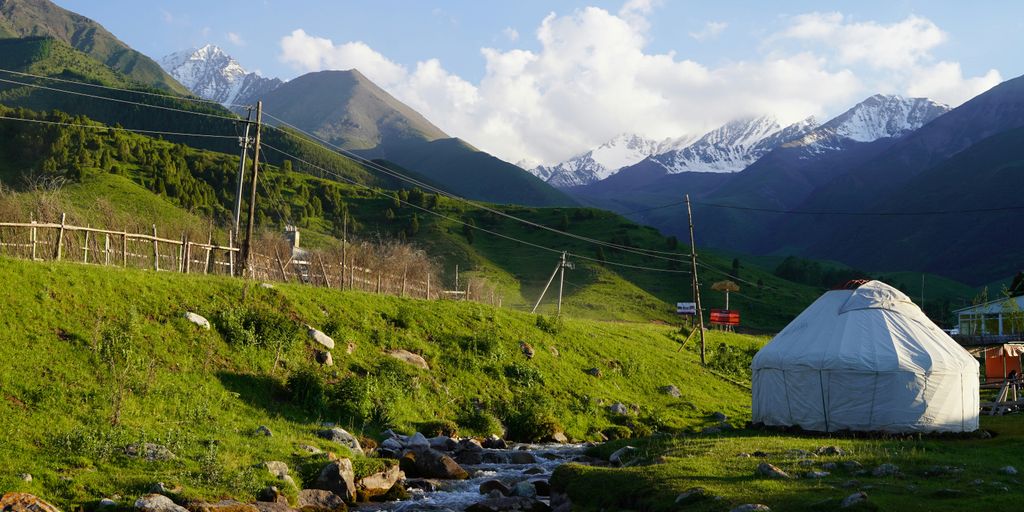Understanding the Difference Between Yurt and Bell Tents: A Comprehensive Guide
Many people are often confused about the difference between Bell Tents and Yurts when it comes to camping or outdoor living. This comprehensive guide will compare these two types of tents in detail, helping you differentiate between them and choose the option that best suits your needs.
Key Takeaways
- Bell Tents are typically dome-shaped with a central support pole, while Yurts have a rounded structure with a wooden frame.
- Bell Tents are generally easier to assemble and more portable than Yurts, making them ideal for short-term camping.
- Yurts are more durable and suitable for long-term living, offering better protection in various climates.
- Bell Tents are usually more affordable and come in a variety of sizes and configurations, whereas Yurts can be customised to meet specific needs but are more expensive.
- Bell Tents provide spacious interiors suitable for families or groups, while Yurts offer a cosy, private space for fewer people.
Origins and Historical Background
The History of Yurts
Yurts have a long history that started in Central Asia. Specifically, they came from Mongolia thousands of years ago. Nomadic tribes first used them as mobile homes due to their practicality and ease of assembly. These structures were essential for survival in the harsh climates of the steppes. Over time, the design of yurts has remained relatively unchanged, a testament to their effectiveness and durability.
The traditional yurt is a marvel of engineering, combining portability with resilience, making it an ideal shelter for nomadic lifestyles.
The Evolution of Bell Tents
Bell tents, on the other hand, have a different origin story. They trace their roots back to military use in the 19th century, particularly by the British Army. These tents were designed for quick assembly and spacious interiors, making them suitable for accommodating multiple soldiers. Over the years, bell tents have evolved from their military origins to become popular in recreational camping and glamping. The concept of glamping, which combines glamour with camping, can be traced back to luxurious tent-living in the 16th century, such as the diplomatic summit in 1520 between Henry VIII of England and Francis I of France.
Structural Differences
Design and Framework
When it comes to the design and framework, yurts and bell tents have distinct characteristics. Yurts are traditionally circular with a wooden frame and a lattice wall structure, providing a sturdy and weather-resistant shelter. Bell tents, on the other hand, have a conical shape supported by a central pole and guy ropes, making them simpler in design but still effective for various weather conditions.
Materials Used
The materials used in constructing these tents also differ significantly. Yurts often utilise natural materials like wood for the frame and felt or canvas for the covering. This makes them not only durable but also eco-friendly. Bell tents typically use heavy-duty canvas, which is waterproof and breathable, ensuring comfort during camping trips or outdoor events.
Understanding the structural differences between yurts and bell tents can help you make an informed decision when choosing the right shelter for your needs. Whether you prioritise durability or ease of setup, knowing these details is crucial.
Highlights
- Design and Framework: Yurts have a circular design with a wooden frame, while bell tents are conical with a central pole.
- Materials Used: Yurts use natural materials like wood and felt, whereas bell tents use heavy-duty canvas.
Highlights
- Design and Framework: Yurts have a circular design with a wooden frame, while bell tents are conical with a central pole.
- Materials Used: Yurts use natural materials like wood and felt, whereas bell tents use heavy-duty canvas.
Usage and Practicality
When it comes to usage and practicality, both yurts and bell tents have their unique advantages. Let’s dive into how each performs in different scenarios.
Camping and Outdoor Activities
Bell tents are a fantastic choice for camping and wilderness activities. They are basic but practical, offering a beautiful natural setting. These tents are lightweight and compact, making them a highly practical solution for hikers. They tackle harsh conditions confidently without giving in to heavy precipitation or high winds. On the other hand, yurts are more suitable for long-term stays and a wide range of climates. They offer a high level of durability, making them ideal for extended outdoor adventures.
Long-term Living
If you’re considering long-term living, yurts are the way to go. They provide a more permanent and durable structure compared to bell tents. Yurts can withstand various weather conditions and offer a comfortable living space for extended periods. Bell tents, while charming and practical for short-term stays, may require extra protection in inclement weather and are not as durable for long-term use.
In summary, bell tents are perfect for short-term camping and outdoor activities, while yurts excel in long-term living and durability.
Assembly and Portability
Ease of Setup
When it comes to setting up, the Bell Tent is a clear winner. It’s typically easier to assemble and disassemble, making it perfect for those who love to move around. You can usually get it up and running in no time, and it folds neatly into a small bag for portability. On the other hand, a yurt requires more time and labour to set up and take down. It’s not the best option if you plan on frequently relocating.
Transportation Considerations
Transporting these structures also varies significantly. Bell Tents are lightweight and compact when packed, so they fit easily into most vehicles. This makes them ideal for spontaneous trips and adventures. Yurts, however, are bulkier and heavier, requiring more effort and space to transport. If you’re planning a long-term stay in one location, a yurt might be worth the extra hassle, but for frequent movers, the Bell Tent is the way to go.
If you’re someone who loves to experience a stylish glamping getaway, the Bell Tent’s ease of setup and portability make it a fantastic choice.
Cost and Customisation
When it comes to cost, bell tents are generally the more budget-friendly option. They come in a variety of sizes and configurations, making them accessible for different needs and preferences. On the other hand, yurts tend to be pricier but offer a higher degree of customisation to meet specific requirements.
Price Comparison
Here’s a quick comparison of the costs:
| Type | Price Range |
|---|---|
| Bell Tents | £500 – £1,500 |
| Yurts | £3,000 – £10,000 |
As you can see, bell tents are typically more affordable, making them a popular choice for casual campers and glamping enthusiasts.
Customisation Options
Bell tents offer a wide range of accessories and enhancements to create the ultimate camping retreat. From intricately patterned canvas to custom furnishings and accessories, you can truly make your bell tent your own. Yurts, while more expensive, can be tailored to meet specific needs, offering a unique blend of style and functionality.
Whether you’re looking for a budget-friendly option or a highly customised living space, both bell tents and yurts have something to offer.
Space and Comfort

Interior Space
When it comes to interior space, both yurts and bell tents offer unique advantages. Yurts typically have a circular layout, which maximises the usable area and creates a spacious, open feel. This design is particularly beneficial for families or groups, as it allows for a communal living space in the centre. On the other hand, bell tents come in various sizes, catering to different needs. For instance, a 4m bell tent can comfortably sleep three to four people, making it ideal for small families or couples who want a bit more room to spread out. High ceilings in bell tents ensure that even the tallest campers can move around comfortably.
Comfort Features
Comfort is a key consideration for both yurts and bell tents. Yurts often come equipped with amenities such as proper beds and even wood-burning stoves, providing a higher level of comfort compared to traditional camping. Bell tents, while simpler, can also be outfitted with various furnishings to enhance comfort. Many people add rugs, cushions, and even small furniture to create a cosy and inviting living space. The versatility of bell tents allows for a range of customisation options, making them a popular choice for those who value both comfort and convenience.
Whether you’re planning a weekend getaway or an extended stay, both yurts and bell tents offer a comfortable and spacious environment to enjoy the great outdoors.
Experience unparalleled space and comfort in our luxurious yurts, designed to offer you a serene escape from the hustle and bustle of everyday life. Whether you’re looking for a romantic getaway or a family adventure, our yurts provide the perfect setting. Discover more about our unique offerings and book your stay today by visiting our website.
Conclusion
In conclusion, both bell tents and yurts offer unique advantages and cater to different needs and preferences. Bell tents, with their elegant design and ease of assembly, are perfect for those seeking a blend of comfort and portability for short-term camping trips. On the other hand, yurts provide a robust and durable option for long-term stays, offering a unique aesthetic and the ability to withstand various weather conditions. By understanding the distinct features and benefits of each, you can make an informed decision that best suits your outdoor living requirements. Whether you choose the classic charm of a bell tent or the traditional allure of a yurt, both options promise a memorable and enjoyable camping experience.
Frequently Asked Questions
What is the main difference between a yurt and a bell tent?
The main difference lies in their structure and design. A bell tent is a dome-shaped tent typically made of waterproof canvas and supported by a central pole. A yurt, on the other hand, is a traditional Mongolian dwelling with a wooden frame and a dome covering.
Which is more suitable for long-term living, a yurt or a bell tent?
Yurts are generally more suitable for long-term living due to their durable structure and ability to withstand various climates. Bell tents are more suited for temporary lodging and short-term camping activities.
How do the assembly and portability of bell tents and yurts compare?
Bell tents are typically easier to assemble and disassemble, and they can be folded into a small bag for portability. Yurts require more time and labour to set up and are less suitable for frequent relocation.
Are bell tents more affordable than yurts?
Yes, bell tents are typically more affordable and come in a wide range of sizes and configurations. Yurts tend to be more expensive but offer a higher level of customisation to meet specific needs.
Can bell tents and yurts be customised?
Both bell tents and yurts can be customised. Bell tents offer various sizes and configurations, while yurts can be tailored to meet specific requirements, including interior layout and materials used.
Which offers more interior space, a bell tent or a yurt?
Bell tents usually offer a more spacious interior suitable for families or groups. Yurts have a unique, cosy interior that may be smaller in comparison but provides a private and comfortable space.





